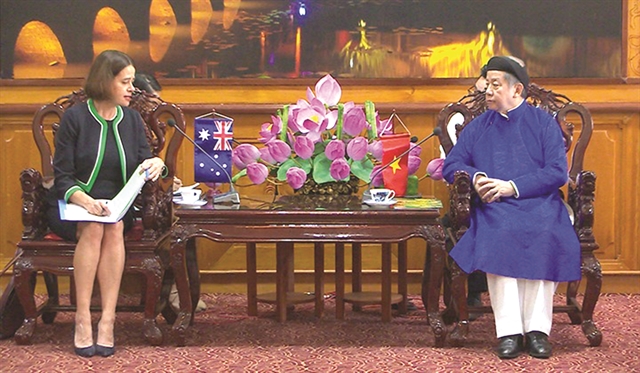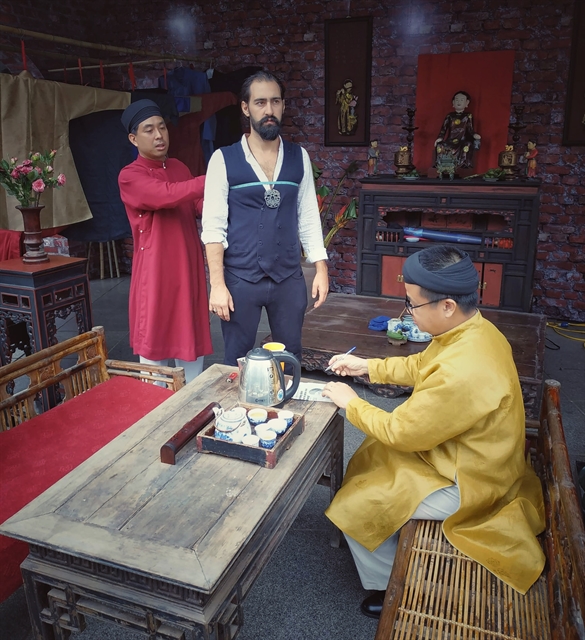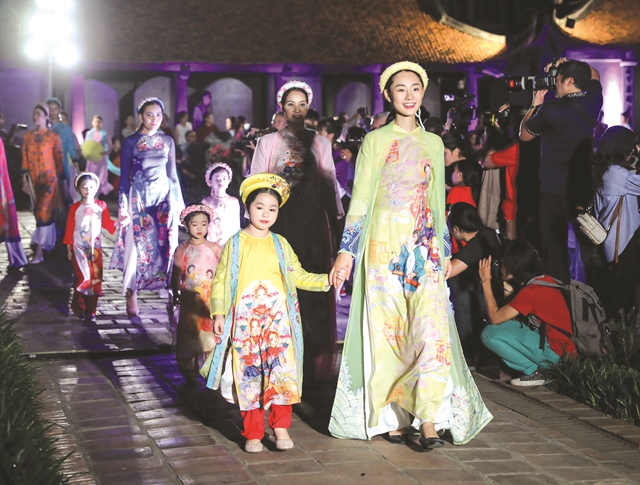
Chairman of the Provincial People's Commitee Phan Ngọc Thọ (right) wears five-flap long dress during a meeting with Australian Ambassador Robyn Mudie on July 10. — Photo https://thuathienhue.gov.vn/
By Minh Thu
Some years ago, Trần Đoàn Lâm, director of the World Publishing House, felt a little uneasy when attending an event during a business trip abroad, where delegates were asked to wear their national costume.
“It would have been easier if I was a woman, as the áo dài (long dress) is famous and a symbol of Vietnamese women’s grace,” he said. “But there is really no national costume for Vietnamese men.”

MADE TO MEASURE: Members of the Đình Làng Việt Group make tailored áo dài for many men, including foreigners. Photo courtesy of the group
Still, he bought a brown, two-flap long dress from one of the many shops near Quán Sứ Pagoda in downtown Hà Nội before he left. Though the problem had passed, he continued to ponder the notion of a “national costume” for men, especially when he saw delegates from Singapore, Malaysia, Indonesia, and Papua New Guinea confidently wearing their outfits.

Khăn xếp is traditionally made from black cloth to help the face brighter. — Photo courtesy of Đình Làng Việt Group
Over recent years, Lâm and members of the Đình Làng Việt (Vietnamese Communal House) Group have worked to promote a “long dress” for men.
They proudly wear áo ngũ thân (a five-flap robe), which originated during the times of Lord Nguyễn Phúc Khoát (1714-1765). In 1744, when he ascended to the throne in Phú Xuân, he issued a decree defining the traditional costume for men and women from all walks of life in Đàng Trong (what is central and southern Việt Nam today). The five-flap robe was considered the national costume for Vietnamese people, but men gradually started to wear Western suits.
“I now confidently wear a five-flap robe to international receptions, meetings, and events,” Lâm said. “It’s becoming more popular among Vietnamese men, including politicians and diplomats.”
“Much effort has been made by the State, the Đình Làng Việt Group, and experts to revive the áo dài as the national costume. But we have to talk more to identify a true áo dài before nominating it to UNESCO as a heritage of humankind.”
Lâm made a presentation on the long dress for men at a national conference held in early July in Hà Nội, where he emphasised that the áo dài is part of the heritage of Vietnamese people and must be preserved and promoted.
Creating popularity
Co-organised by the Ministry of Culture, Sports and Tourism and the Việt Nam Women’s Union and with the aim of recognising the history, identity, and cultural value of the áo dài, the conference was one of a number of steps in compiling a dossier for submission to UNESCO, the UN cultural agency, seeking recognition of the traditional costume as a heritage of humankind. A range of scholars attended and shared their views.
Famed researcher of national costumes, Trịnh Bách, said áo dài for women have been reimagined many times, while the version for men has hardly changed at all over the centuries.
Changes made to the áo dài during the last century added western cuts to the long robes and gave the colours more nuances and shades, making the women look much more attractive, dynamic and fresher, rather than quiet and obedient.
“The traditional long dress is imprinted in Vietnamese people’s minds as the national costume,” he said.
“Our ancestors made specific creations and gave it an identity, so it would hold a position similar to that of the kimono in Japan and the hanbok in Korea. The Encyclopaedia Britannica also mentions the áo dài.”
“With its own colours and identity, the áo dài should be honoured as a heritage of humankind under UNESCO’s criteria.”
Painter Nguyễn Đức Bình, founder of the Đình Làng Việt Group, said the long dress for men has a basic design, with a straight neck and five flaps of cloth running along the body: two in front, two at the back, and one shorter layer underneath the two front flaps. The two layers join each other by a row of five buttons running from the neck to underneath the arms.
“It creates elegance and refinement for the wearer,” Bình said.
“People may make certain judgements about the wearer, saying it’s from feudal times or it’s old-fashioned or effeminate. The original actually had no patterns and was a single colour.”
“So, we have to promote the true identity and value of the long dress, to help people fully understand what it is.”
Trịnh Thu Thủy, deputy minister of Culture, Sports and Tourism, agreed that it’s necessary to identify the values and characteristics of cultural heritage when compiling the dossier for UNESCO recognition.
“Research would help identify how to manage and protect the cultural heritage of the áo dài and guarantee its vitality and role in modern times,” she said.
The chairman of the Thừa Thiên-Huế Provincial People’s Committee, Phan Ngọc Thọ, wore a five-flap robe at a meeting with Australian Ambassador Robyn Mudie on July 10, in an attempt to promote the traditional costume. He is one of only a few senior officials willing to wear the costume at formal events.
“We will introduce plans to encourage people to wear the long dress, not only at traditional rituals and celebrations but also at communal events, to affirm the áo dài as Việt Nam’s national costume,” he said at a conference in Huế last month.
“I will wear one to meetings with foreign delegates, to promote the costume and provide an example for other officials.”
“I ask that teachers, students, and officials in Huế wear an áo dài at least twice a week. Women doing so will receive free tickets to the Huế Royal Citadel during festivals.”

Models perform new designs of áo dài during a fashion show on June 28 at the Temple of Literature. More than 1,000 designs were showcased as an attempt to promote images of traditional long dress. — VNS Photo Minh Khánh
Taking the áo dài to the world
Designer Đỗ Trịnh Hoài Nam, who has presented áo dài collections at many international fashion shows worldwide, said the journey to introduce the costume to the world had not been easy.
“Heritage can be preserved and promoted only when it’s integrated into contemporary life,” he said.
“The long dress is known around the world as part of Việt Nam’s cultural heritage, but it’s not easy to promote it in different cultures and still preserve its identity.”
“I often add local characteristics to my áo dài collections, such as architecture, cultural beauty, the national flag, or landscapes. International audiences can then enjoy both the costume and images of Việt Nam.”
“I also combine images of the countries where the collections are held. They often attract the attention of foreigners. For example, the collection ‘Women in Love’ was presented in Paris, and contains images of the Notre Dame Cathedral and symbols of European arts.”
“Sometimes, áo dài have patterns and details from global fashion trends added, to attract the attention of international audiences.”
Nguyễn Thị Thu Trang from the Cultural Heritage Department said the dossier for the áo dài should be in line with the 2003 UNESCO Convention for the Safeguarding of the Intangible Cultural Heritage and Việt Nam’s Law on Cultural Heritage.
“We should follow UNESCO’s criteria to compile the dossier, as regards its characteristics, the process of making one, the wearers, and the cultural space the áo dài resides in,” she said. VNS
OVietnam